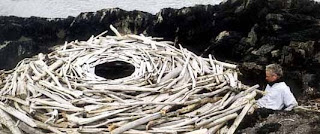

The Victory Stele of Naram-Sin of the
Akkadian Empire 2254-2218 BCE arises as a crucial piece in Art History as it reflects the importance of scale, focal point and unity in analyzing art what it has to say about its subject.
One important element of the Victory Stele is the hierarchy of scale which the artist uses to emphasize the power and influence Naram-Sin at the moment of victory. Naram-Sin develops as the focal point of this piece as he is clearly much taller than any other figure on the stele. This increased scale reflects his power, influence, and strength as he stands proud among his much smaller enemies.
This central figure's stance also contributes to this sense of power. His body is positioned with his head and feet facing forward in profile to reflect motion and progress while his shoulders are shown as broad to reflect his strength. By contrast, the his troops are much less distinguished, only revealing great repetition to reflect the order and unity of the subordinates as they look to Naram-Sin for guidance.
In addition to composition, cultural elements also bring to light the importance of this central figure. For example, the articles of clothing which he wears as well as his weapon all reflect different element of his influence. For example, his helmet with horns may be interpreted to reflect his divine power. By contrast, his enemies are naked to show their weakness in contrast to the king.
It is also the interactions of the subjects which develop this impression of influence. While the troops all face Naram-Sin, the king himself looks to the heavens for guidance. The suns located at the top of the stele reflect this idea of his divine power to give a sense that his actions are ordained by God and he therefore shows his respect.
By analyzing composition, scale, cultural elements and the interactions of the subject, much can be understood or interpreted of the piece in regards to the culture, society and subjects.


Many of these same techniques are repeated throughout history, as exemplified by
Napoleon Crossing the Alps of 1800. Once again, the leader is emphasized as the focal point. Though Napoleon is known for being rather short, he now dominates the scene with a confident attitude and glorious appearance. His clothing reflects his high rank, the color red symbolizes power and control and his horse displays a sense of adventure. At his feet are the names of powerful men, reflecting the figures who have influenced him as well as his influence on the world. In contrast to his dark and tresherous surroundings, Napoleon arises as a light as knowledgeable figure who is ready for the challenge ahead of him.
Cultural and historical figures of importance such as Naram-Sin and Napoleon often relied of these artistic techniques to convey power and control.




















